In the ever-evolving landscape of web development, the ability to create rich, interactive experiences directly in the browser remains a key driver of innovation. While frameworks discussed in React News or Vue.js News dominate the application space, dedicated game development frameworks are essential for crafting compelling games. Among these, Phaser stands out as a powerful, mature, and feature-rich 2D game framework for HTML5. It provides developers with the tools to build high-performance games that run on both desktop and mobile browsers. Recent developments in the ecosystem, often highlighted in Phaser News, focus on streamlining the development process, making it easier than ever for both newcomers and seasoned developers to bring their ideas to life. This article explores the core concepts of Phaser, dives into modern implementation details, covers advanced techniques, and outlines best practices for building scalable and optimized web games.
Understanding the Core Architecture of a Phaser 3 Game
At its heart, a Phaser game is built around a simple yet powerful structure: the Game instance and Scenes. The Game instance is the central hub of your application, managing the renderer (Canvas or WebGL), input systems, and the main game loop. Scenes are the building blocks of your game’s logic and content. You can think of a Scene as a distinct state or screen, such as a main menu, a level, or a game-over screen. This modular approach is fundamental to organizing your code effectively.
The Game Configuration
Every Phaser game begins with a configuration object. This object tells Phaser how to set up the game canvas, which physics engine to use, and which scenes to load. This initial setup is crucial for defining the foundational properties of your game.
// main.js
import Phaser from 'phaser';
// A simple scene for demonstration
class BootScene extends Phaser.Scene {
constructor() {
super({ key: 'BootScene' });
}
preload() {
// This is where you would load your game assets
console.log('Assets will be loaded here.');
}
create() {
// This is where you set up your game objects
this.add.text(400, 300, 'Hello, Phaser!', {
fontSize: '32px',
fill: '#ffffff'
}).setOrigin(0.5);
}
}
// The main game configuration object
const config = {
type: Phaser.AUTO, // Automatically choose between WebGL or Canvas
width: 800,
height: 600,
parent: 'game-container', // ID of the DOM element to attach the canvas to
physics: {
default: 'arcade',
arcade: {
gravity: { y: 200 },
debug: false
}
},
scene: [BootScene] // An array of scenes to add to the game
};
// Create a new Phaser Game instance
const game = new Phaser.Game(config);In this example, we define a configuration with a specific width and height, enable the built-in Arcade Physics engine, and register a single scene called BootScene. This modularity is a key theme in modern JavaScript development, echoed in trends from Node.js News to frontend frameworks like Angular and Svelte.
The Scene Lifecycle
Each Phaser Scene has a lifecycle composed of several key methods that are called automatically by the game engine. The most important ones are:
preload(): This method is called first. Its purpose is to load all the necessary assets for the scene, such as images, spritesheets, audio files, and tilemaps. Phaser’s loader handles all the asynchronous loading for you.create(): This method is called once all assets inpreload()have been loaded. This is where you set up the initial state of your scene by creating game objects like sprites, text, and groups, and setting up input listeners.update(time, delta): This method is the heart of the game loop. It is called on every frame, allowing you to update the state of your game, check for collisions, handle player input, and move objects around. Thedeltaparameter provides the time in milliseconds since the last frame, which is crucial for frame-rate independent movement.
Implementing Core Game Mechanics
With the basic structure in place, the next step is to implement interactive mechanics. This involves creating sprites, responding to user input, and using the physics engine to manage movement and collisions. Modern build tools, often discussed in Vite News and Webpack News, are invaluable here for managing asset pipelines and enabling features like hot-reloading for a faster development cycle.

Creating and Controlling a Player Sprite
Let’s expand our scene to include a player character that can be moved with the keyboard. First, we need to load an image for our player in the preload method. Then, in create, we’ll create a physics-enabled sprite and set up keyboard controls.
// GameScene.js
import Phaser from 'phaser';
class GameScene extends Phaser.Scene {
constructor() {
super({ key: 'GameScene' });
this.player = null;
this.cursors = null;
}
preload() {
// Load a simple player image
this.load.image('player', 'assets/player-ship.png');
}
create() {
// Create the player sprite and enable physics
this.player = this.physics.add.sprite(400, 500, 'player');
// Prevent the player from falling off the screen
this.player.setCollideWorldBounds(true);
// Create cursor keys for keyboard input
this.cursors = this.input.keyboard.createCursorKeys();
}
update() {
// Reset player velocity
this.player.setVelocity(0);
// Horizontal movement
if (this.cursors.left.isDown) {
this.player.setVelocityX(-200);
} else if (this.cursors.right.isDown) {
this.player.setVelocityX(200);
}
// Vertical movement
if (this.cursors.up.isDown) {
this.player.setVelocityY(-200);
} else if (this.cursors.down.isDown) {
this.player.setVelocityY(200);
}
}
}In the update loop, we continuously check the state of the cursor keys. If a key is pressed, we set the player’s velocity accordingly. This simple polling method is effective for continuous movement. This pattern of a stateful component being updated on a “tick” is common not just in game development but also in complex data visualization libraries like Three.js News and PixiJS News, the latter of which is the powerful rendering engine that Phaser uses under the hood.
Advanced Techniques: TypeScript and State Management
As your game grows in complexity, maintaining a plain JavaScript codebase can become challenging. Adopting modern development practices, such as using TypeScript for type safety and implementing a clear state management strategy, can significantly improve code quality and scalability. The benefits of strong typing are a frequent topic in TypeScript News and have influenced the entire web ecosystem, from backend frameworks discussed in NestJS News to frontend libraries covered in Angular News.
Integrating TypeScript for Robust Code
Phaser has excellent TypeScript support, providing official type definitions that enable autocompletion and compile-time error checking. Converting a Scene to TypeScript involves defining types for your class properties and using Phaser’s provided types for game objects.
// GameScene.ts
import * as Phaser from 'phaser';
export class GameScene extends Phaser.Scene {
private player!: Phaser.Physics.Arcade.Sprite;
private cursors!: Phaser.Types.Input.Keyboard.CursorKeys;
private readonly PLAYER_SPEED: number = 250;
constructor() {
super({ key: 'GameScene' });
}
preload(): void {
this.load.image('player', 'assets/player-ship.png');
}
create(): void {
this.player = this.physics.add.sprite(400, 500, 'player');
this.player.setCollideWorldBounds(true);
if (this.input.keyboard) {
this.cursors = this.input.keyboard.createCursorKeys();
}
}
update(): void {
this.player.setVelocity(0);
if (this.cursors.left.isDown) {
this.player.setVelocityX(-this.PLAYER_SPEED);
} else if (this.cursors.right.isDown) {
this.player.setVelocityX(this.PLAYER_SPEED);
}
if (this.cursors.up.isDown) {
this.player.setVelocityY(-this.PLAYER_SPEED);
} else if (this.cursors.down.isDown) {
this.player.setVelocityY(this.PLAYER_SPEED);
}
}
}Notice the use of types like Phaser.Physics.Arcade.Sprite and the explicit declaration of class properties. The non-null assertion operator (!) is used for player and cursors because we know they will be initialized in the create method, satisfying the TypeScript compiler. This structured approach helps prevent common runtime errors and makes refactoring much safer.
Managing Game State Across Scenes
For complex games, you often need to share data between scenes—for example, the player’s score, health, or inventory. While you can pass data when starting a new scene, a more robust solution for global state is to use Phaser’s built-in Data Manager or a dedicated global state object.

A simple approach is to create a central registry or service that scenes can access. Here’s a conceptual example of managing a global score.
// registry/GameRegistry.js
class GameRegistry {
constructor() {
this.score = 0;
this.level = 1;
}
incrementScore(amount) {
this.score += amount;
}
getScore() {
return this.score;
}
}
// Create a singleton instance
export const registry = new GameRegistry();
// In any scene:
import { registry } from './registry/GameRegistry';
class HUDScene extends Phaser.Scene {
create() {
this.scoreText = this.add.text(10, 10, `Score: ${registry.getScore()}`, {
fontSize: '24px',
fill: '#fff'
});
}
update() {
// This could be driven by an event emitter for better performance
this.scoreText.setText(`Score: ${registry.getScore()}`);
}
}This pattern decouples the game state from any single scene, making it easier to manage and persist data across your entire game. This separation of concerns is a core principle in software engineering, whether you’re building a game with Phaser or a web app with tools discussed in Next.js News or RedwoodJS News.
Best Practices and Performance Optimization
Writing functional code is just the first step; creating a polished and performant game requires attention to detail and adherence to best practices. This involves structuring your project logically, managing assets efficiently, and optimizing your game loop.
Project Structure and Scalability
A well-organized project is easier to maintain and scale. A common and effective structure is to separate your code by function:

/src/scenes/: Contains all your game scene files (e.g.,MainMenuScene.js,Level1Scene.js)./src/sprites/or/src/game-objects/: For custom sprite classes that extendPhaser.GameObjects.Sprite./src/helpers/or/src/utils/: For utility functions and helper classes./src/ui/: For UI components like buttons, scoreboards, etc./public/assets/: The location for all your static game assets (images, audio).
Performance Considerations
Performance is critical for a smooth gameplay experience. Here are a few key optimization tips:
- Object Pooling: Instead of destroying and recreating objects that are frequently used (like bullets or enemies), reuse them from a pre-allocated “pool.” This reduces garbage collection and improves performance.
- Texture Atlases: Combine multiple small images into a single large spritesheet, known as a texture atlas. This reduces the number of draw calls the GPU has to make, which is a major performance bottleneck. Tools like TexturePacker are excellent for this.
- Avoid Heavy Logic in
update(): Theupdateloop runs on every frame. Avoid complex calculations, memory allocations, or intensive DOM manipulations inside it. Use timers or conditional checks to run expensive logic less frequently. - Physics Body Optimization: Keep your physics bodies as simple as possible. Use circles or rectangles instead of complex polygons where feasible. Disable physics on objects that don’t need to move or collide.
Keeping up with news from the broader ecosystem, such as performance improvements in JavaScript engines covered in Bun News or Deno News, can also provide insights into writing more efficient code.
Conclusion: The Future of Web Game Development with Phaser
Phaser continues to be a dominant force in HTML5 game development by providing a stable, feature-rich API while embracing modern JavaScript practices. The framework’s focus on simplifying the developer experience—through clear documentation, powerful built-in systems like physics and input, and community-driven tools—makes it an excellent choice for projects of any scale. By combining Phaser’s core strengths with modern tooling like Vite and TypeScript, and by following established best practices for project structure and performance, developers can build incredible 2D games that are accessible to anyone with a web browser.
As you embark on your next project, consider starting with one of the many available templates to get a head start. Explore the extensive plugin ecosystem to add new capabilities, and don’t hesitate to dive into the official documentation, which is a treasure trove of examples and in-depth explanations. The world of web game development is more vibrant than ever, and Phaser provides a fantastic gateway to creating your own interactive experiences.

